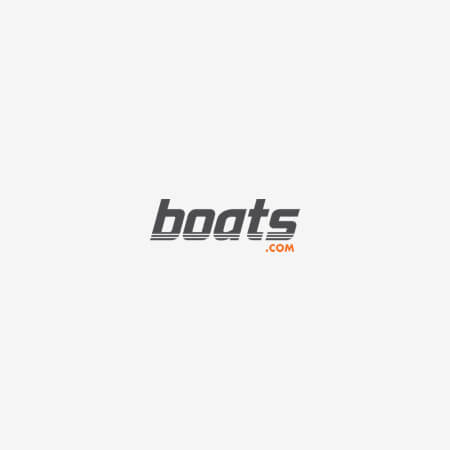Inside the NMEA Conference: The Future of Marine Electronics and Connected Boating
Marilyn DeMartini rounds up some of the new technological innovations and highlights from the NMEA 2025 conference.
“We make connections,” says Mark Reedenauer, President and Executive Director of the National Marine Electronics Association (NMEA), a professional organization that began in 1957, as a group of marine dealers and installers. As a trade association that has evolved over decades with its industry, the NMEA ensures that all marine devices, systems, components software and hardware communicate with each other. It is therefore important that this group also gather for an annual conference to communicate in person with each other as well.
2025 NMEA Conference Highlights
This year’s conference was a buzz of techies from all parts of the marine industry from satellite communications, lighting and VHF radios to security systems, batteries and multi-functional displays—and everything in between. And oh, “there’s an app for that,” as many software programs were introduced to facilitate scheduling and communications for boaters, builders and service providers.
Asking several attendees about the biggest issues in marine electronics today, I gathered distinct responses:
- Mark Reddenauer, NMEA – Need for consumer electronics training.
- Rogan Van Gruisen, Cay Electronics Marine Systems Engineers – Increased power needs due to the amount of “stuff” people now want added to their boats.
- Ron Muller, Electronics Unlimited, engineer, service and installer – Need for better customer service—raising the standards.
- Kevin Kates, YachtLogic, Marine Business app – Need to streamline workloads through technology.
Some of these above issues were addressed in a prior article I wrote for Boat Trader but overwhelmingly, the numbers and sophistication of the devices that are added to boats were a major focus of the show. Each vendor booth displayed technology that could make operations easier, IF we all knew how to use it, which ties into the training that NMEA is constantly expanding to help service providers as well as boaters.
Such operation also ties into navigating—literally and figuratively by our phones. The plethora of apps which increasingly crowd our phone home pages are now nearly necessary, and certainly adopted by the younger generation, which leaves many “mature” boaters and service providers in discovery mode.
Examples Of New Technologies
Yacht Logic Pro is one of those apps that was developed by a seasoned fisherman, businessman and yacht owner because what he needed to simplify his crew’s work scheduling was not available. He started in 2007 and as technology advanced, so did his platform. Yacht Logic Pro is now an app that works to simplify job creation, digital estimates and signatures, job and team management—all managed live on a mobile device and synchronized with QuickBooks for billing. While the current version is best for marine service providers, the next generation will be yacht management to schedule and log all yacht services and connect with service providers. www.yachtlogicpro.com
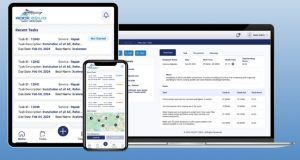
Above: The app for for Marine Repair and Detailing Businesses. Image by Yacht Logic Pro.
Several “Man Overboard” programs caught my attention as the lanyards required are just not user-friendly—we forget about them and the U.S. Coast Guard has approved these wearable alternatives that provide even more assistance than just engine cutoff.
1st Mate Marine Safety & Security System uses wireless communication between wearable fobs to alert on Man Overboard, distress messaging and theft deterrence. Up to seven passengers can be linked to a captain. Falling overboard stops the engine, then a distress signal is sent to emergency accounts. The Theft Deterrent System (TDS) locks your engine to prevent theft or any unauthorized user. This Brunswick company is compatible with Mercury SmartCraft engines and other leading engine brands and after purchasing the devices, there are no monthly fees with updates being done for free. www.1stmate.com
MOB+ by Fell Marine is also a wearable device—on wrist or on a lanyard around the neck or clipped to a personal floatation device. Also ABYC and U.S. Coast Guard compliant, the fobs can be connected to the captain’s xHUB—mounted on or near the boat console. The two communicate wirelessly and stop the engine if the xFOB is submerged in the water or is beyond the range of the xHUB. Each fob has 300 hours of battery life. The dash device has a light and sound alarm, a pairing, override and stop button and an external antenna. https://buy.fellmarine.com/collections/mob-wireless-man-overboard-system
OLAS Smart Protection by Exposure Marine can be used by solo boaters or on large boats. The solo mode can be activated by the mobile app to track a tag or can be linked to any OLAS hub to cut off the engine. It autonomously transmits a text message to a specified recipient, including time and location which can be cancelled upon rescue. The overboard alarm can monitor up to 25 transmitters for vessels over 125’. GPS coordinates are saved for accurate return to point for rescue. Various alarms depend on use but all activate an 85-decible alarm and a red LED display. Either use the OLAS N2K version, plugged into the NMEA system which registers on the chart plotter or the OLAS Guardian cordless engine cut off. Tags are run by battery, USB rechargeable transmitter with vibration alert or are available on a USB chargeable torch with water-activated floating strobe. www.exposuremarine.com
While FLIR thermal imaging cameras can detect a man overboard, what about submerged items, buoys or items that have the same ambient temperature as the water? The SIONYX Nightwave ultra, low-light marine camera is powered by a patented sensor that enables detection of obstacles or debris in moonless starlight. Flexible mounting of the 5” square camera and setup processes are adaptable for any boat and integrate with existing hardware for full-color digital night vision. www.sionyx.com
Several other companies join in the quest to help boaters with situational awareness in night boating or in poor visibility situations.
The Lookout Camera and its accompanying LookOut BrainPro includes night vision, wide angle and zoom, 360-degree panorama and navigational light, and it works with all major display manufacturers.
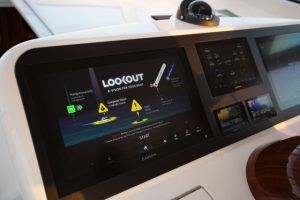
Above: The LOOKOUT System, the AI system for safer boating. Image by LOOKOUT.
The cameras, which draw data from charts, computer vision and radar, are mounted on the boat top, integrate with an onboard “brain” that is powered by Nvidia’s high grade visuals which are then relayed to the dash display unit in 3D augmented reality view. www.getalookout.com
And of course, AI was prominently touted in many displays. SEA.AI offers a range of machine vision systems that detect, identify and monitor floating objects, persons, other vessels and obstacles of any size or type, day or night and even in difficult conditions. SEA-AI enhances a boater’s comprehensive view of the vessel’s surroundings. www.sea.ai.com
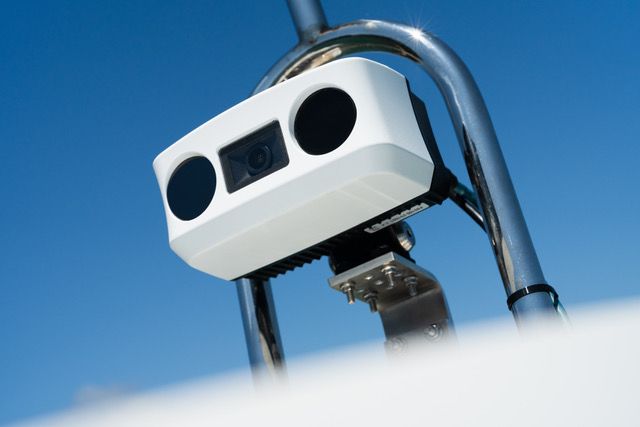
Above: A SEA AI Watchkeeper Polaris. Image by SEA AI.
Power-Pole shallow water anchors and MOVE brushless trolling motors are now coupled with Power-Pole VISION, a mountable “Infotainment Center” that not only manages your Power-Pole products but also interfaces with Google to access all your Google Play Store apps for navigation, fishing and entertainment. All done with voice commands and a glare-free high-definition screen with a built-in HD camera, you can leave your phone safely tucked away and rely on VISION to see everything! www.power-pole.com/vision
METROMARINE Lighting uses patented Ultraviolet technology (UVC) in a dry gas assembly to prohibit biofouling growth on its clear precision optical light lenses and prevents moisture from infiltrating its underwater and marine LED fixtures. METROMARINE manufactures full-spectrum-colored lights for boats, docks and supporting accessories and offers a 3-year warranty on fixtures and a 2-year warranty on cables and accessories. www.metromarinelighting.com
Cay Electronics, marine system engineers and distributors of various brands of marine electrical equipment, presented a seminar on lithium batteries and mentioned its own invention, the CayCube, a Newport for New Products 2025, awardee for the Best Green/Innovation Product. The CayCube is a solid-state, fully silent electric 5kW/20KWh power source designed to replace traditional gas-powered generators on boats and in other applications like off-grid homes, emergency backup and construction job sites.
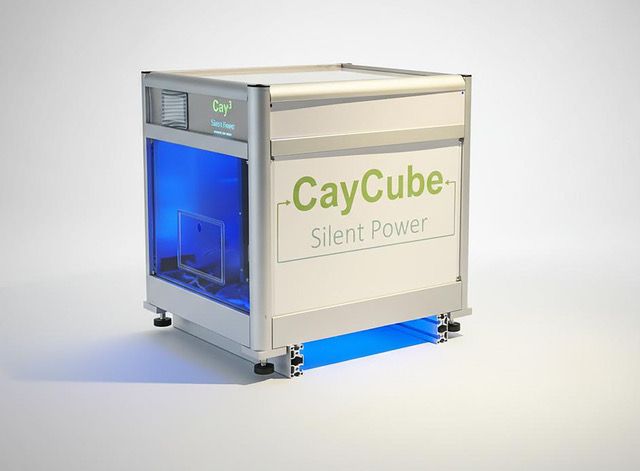
Above: A CayCube product, image by CayCube.
Its AC output, energy storage capacity, peak output power and other specifications verify its use for what the company calls “real-world performance” to run everything from air conditioning, refrigeration, battery charger, freezer, ice maker, microwave and a Seakeeper for a significant amount of hours. www.caycube.com
And since connectivity is everything in today’s connected world, WAVE WIFI provides one integrated solution for dependable marine internet, uniting Starlink, Cellular and WiFi. Currently integrated with Furuno MFDs, with others to come soon, WAVE WiFi uses free marina WiFi when docked, then relies on Starlink offshore to maximize affordable options and minimize more expensive options. www.wavewifi.com
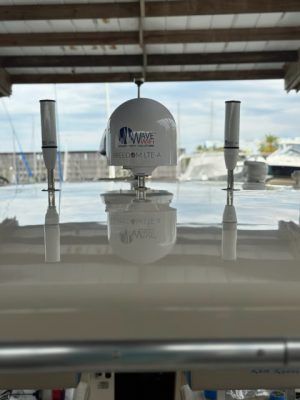
Above: Wave WiFi's FREEDOM LTE-A Dome. Image by Wave Wifi.
Key Take Aways
Though many of the technologies displayed at the NMEA conference seemed overwhelming in detail, Reedenauer maintains that “Technology is making things easier” while recognizing that the “Installer may also have to be an IT guy. In complex systems, it is not just ‘plug and play’ ” he says, so everyone should consider NMEA training. Luckily, NMEA provides a variety of educational opportunities geared to industry professionals, but now also to non-professionals and technical boaters who want the education if not the certification.
Electronics Unlimited Muller added, “NMEA brings people together, sets communication standards and provides training” and that role has had a major impact on the marine industry which has grown and changed along with all the technologies that make it “easier” yet more complicated.
For more information visit NMEA.org









